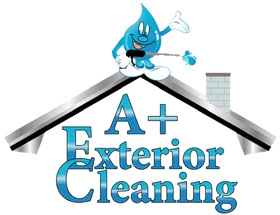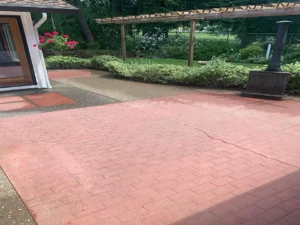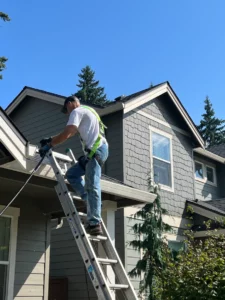Why Moss Grows on Roofs in Damp Climates (and How to Stop It)
Have you ever noticed a velvety green blanket covering rooftops in your neighborhood? While it might look charmingly rustic, that green layer is actually moss, and it can spell trouble for a homeowner. Moss on a roof is more than just a cosmetic issue; it’s a sign of potential damage that, if left unaddressed, could lead to costly repairs.
This guide will explain why moss thrives on roofs, particularly in damp climates, and what you can do about it. We will cover the types of roofs most affected, the damage moss can cause, and effective prevention and removal strategies. Understanding the root cause of this persistent plant is the first step toward protecting your home and preserving its value. Whether you prefer a DIY approach or want to call in the professionals for roof moss removal, we have the information you need to keep your roof clean and healthy.
Why Moss Loves Your Roof
Moss is a simple, non-vascular plant that reproduces through spores, not seeds. Unlike more complex plants, it doesn’t have roots to absorb water. Instead, it soaks up moisture directly through its leaves. This characteristic is precisely why it flourishes in certain environments and finds rooftops so inviting. Several key factors contribute to moss growth on roofs.
Abundant Moisture
Moisture is the single most important ingredient for moss. In regions with frequent rainfall, high humidity, and overcast skies, roofs can remain damp for extended periods. This constant moisture provides the perfect breeding ground for moss spores to germinate and grow. North-facing roof slopes, which receive less direct sunlight, are particularly prone to staying wet longer and thus are more susceptible to moss infestations.
Lack of Sunlight
Shade is another critical component for moss. Areas of a roof that are shaded by large, overhanging tree branches or are positioned to receive minimal sunlight create a cool, damp haven. Sunlight helps evaporate moisture from the roof surface, so its absence allows the roof to stay wetter for longer, encouraging moss to take hold. If your property is surrounded by tall trees, you might notice more significant moss growth on the shaded sections of your roof.
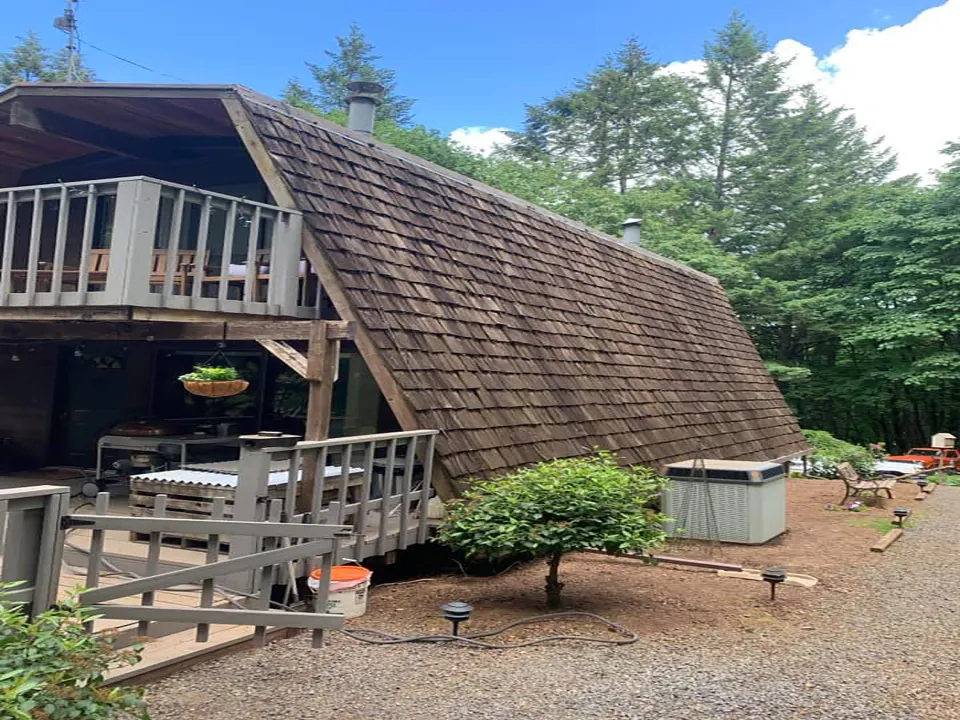
Debris and Organic Matter
Fallen leaves, pine needles, twigs, and dirt that accumulate on a roof act like a sponge, trapping moisture and providing a nutrient-rich base for moss. As this organic material decomposes, it creates a fertile soil-like layer where moss spores can easily anchor and begin to grow. Gutters clogged with debris can also cause water to back up onto the roof, creating persistently damp areas that are ideal for moss.
Roof Material and Texture
The type of material your roof is made from also plays a role. Rough, textured surfaces like those found on asphalt shingles or wood shakes offer tiny nooks and crannies where spores and debris can collect. These textures provide a secure foothold for moss to establish itself. In contrast, smoother surfaces like metal roofing are less hospitable to moss growth.
Spore Dispersal
Moss spores are incredibly lightweight and can travel long distances on the wind. If nearby homes or trees have existing moss growth, it’s highly likely that spores will find their way to your roof. Birds and squirrels can also transport spores. Once they land in a suitable damp and shady spot, they can quickly begin to colonize.
Roof Types Most Susceptible to Moss
While moss can technically grow on any surface if conditions are right, some roofing materials are far more prone to it than others. The texture, porosity, and composition of the roofing material can either encourage or deter moss growth.
Asphalt Shingles
Asphalt shingles are one of the most common roofing materials in North America, and unfortunately, they are highly susceptible to moss. The granular surface of these shingles provides an excellent texture for moss spores to attach to. Furthermore, many asphalt shingles contain limestone as a filler, which acts as a food source for moss and algae. Over time, as the granules wear away, the organic, asphalt-based core becomes exposed, providing even more nutrients for moss to thrive on.
Wood Shakes and Shingles
Wooden roofs, while beautiful, are prime real estate for moss. Wood is a natural, organic material that retains moisture, especially in shaded, damp climates. Cedar, a common wood used for roofing, contains natural oils that are resistant to decay and insects, but this resistance diminishes over time. As the wood ages and weathers, it becomes more porous and absorbent, creating an ideal, nutrient-rich environment for moss to flourish.
Clay and Concrete Tiles
Tile roofs can also be vulnerable to moss, particularly older, unsealed tiles. The porous nature of clay and concrete allows them to absorb and hold moisture. Moss can grow in the crevices between tiles and on the surface of the tiles themselves, especially if they have a rough finish. The overlapping design of tile roofing can also trap debris and moisture, further encouraging growth.
Slate Roofs
Slate is a natural stone and is generally less porous than other materials, making it more resistant to moss. However, moss can still grow in the joints and crevices between the slate tiles where moisture and organic debris accumulate. A very old slate roof with surface irregularities may also provide a foothold for moss.
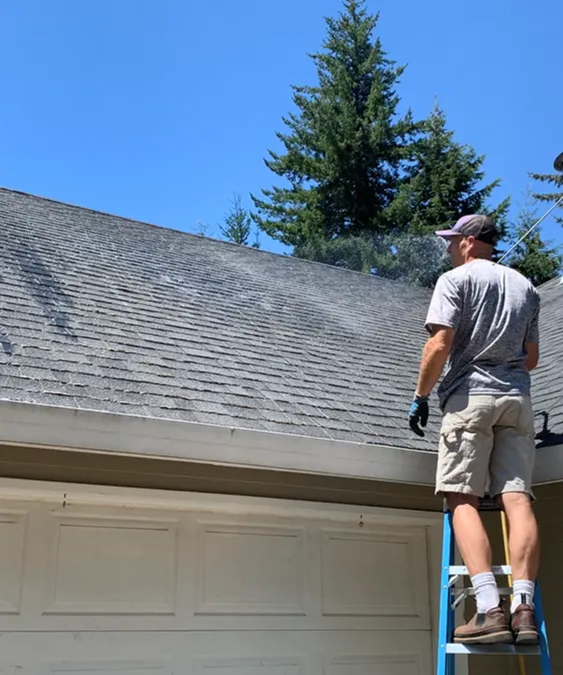
The Damage Moss Can Cause to Your Roof
Ignoring a roof moss problem can lead to significant and expensive structural damage. Here’s a breakdown of the problems moss can create.
Water Damage and Leaks
Moss acts like a sponge, absorbing and holding large amounts of water. This constant moisture saturation can cause the underlying roofing materials to rot and deteriorate. On asphalt shingle roofs, this can lead to the granules wearing away, exposing the matting underneath to UV rays and causing it to become brittle.
As moss thickens, it can also grow underneath the edges of shingles and tiles, lifting them up. This uplift breaks the watertight seal between shingles, creating channels for water to seep underneath. This water can then penetrate the roof deck, leading to rot, mold growth in the attic, and leaks inside your home.
Structural Damage from Freeze-Thaw Cycles
In climates with freezing temperatures, the water held by moss can cause severe damage. When the water-soaked moss freezes, it expands. This expansion can push up against shingles and tiles, widening cracks and causing the materials to break. This “frost-heave” effect accelerates the deterioration of the roof, leading to significant damage that can compromise the entire structure.
Clogged Gutters and Drainage Issues
Moss on the roof often gets dislodged by rain or wind and washed into the gutters. Large clumps of moss can quickly block gutters and downspouts, preventing proper drainage. When gutters overflow, water can spill down the side of the house, damaging the siding, foundation, and landscaping. It can also back up onto the roof, exacerbating moisture problems at the roof’s edge.
Reduced Lifespan of Your Roof
All these factors combined—moisture retention, shingle damage, and structural stress—significantly shorten the lifespan of your roof. A roof that might have lasted 25 years could require replacement in just 15 if a severe moss problem is left untreated. The cost of a full roof replacement is substantial, making moss prevention and removal a critical part of home maintenance.
How to Prevent and Remove Moss
Fortunately, there are several effective methods for dealing with moss on your roof. The right approach will depend on the severity of the growth and your comfort level with working at heights.
DIY Moss Removal Techniques
For minor moss problems, a DIY approach might be suitable. However, safety is paramount. Always use a sturdy, well-placed ladder and wear non-slip footwear. Never walk on a wet, mossy roof, as it can be extremely slippery.
Gentle Brushing: For light moss growth, you can use a long-handled, soft-bristle brush to gently scrub the moss off the shingles. Work from the top of the roof downwards to avoid lifting the shingles. Never use a pressure washer or a stiff-bristled brush, as these can blast away the protective granules on asphalt shingles and cause irreparable damage.
Moss-Killing Solutions: There are many commercial moss-killing products available. These typically come in a spray formula that you apply to the roof. Most products require you to wait for the moss to die and turn brown before rinsing it away with a garden hose. Always follow the manufacturer’s instructions carefully and take precautions to protect surrounding plants from chemical runoff. You can also make a homemade solution with equal parts water and distilled white vinegar, but be aware this can be less effective on heavy infestations.
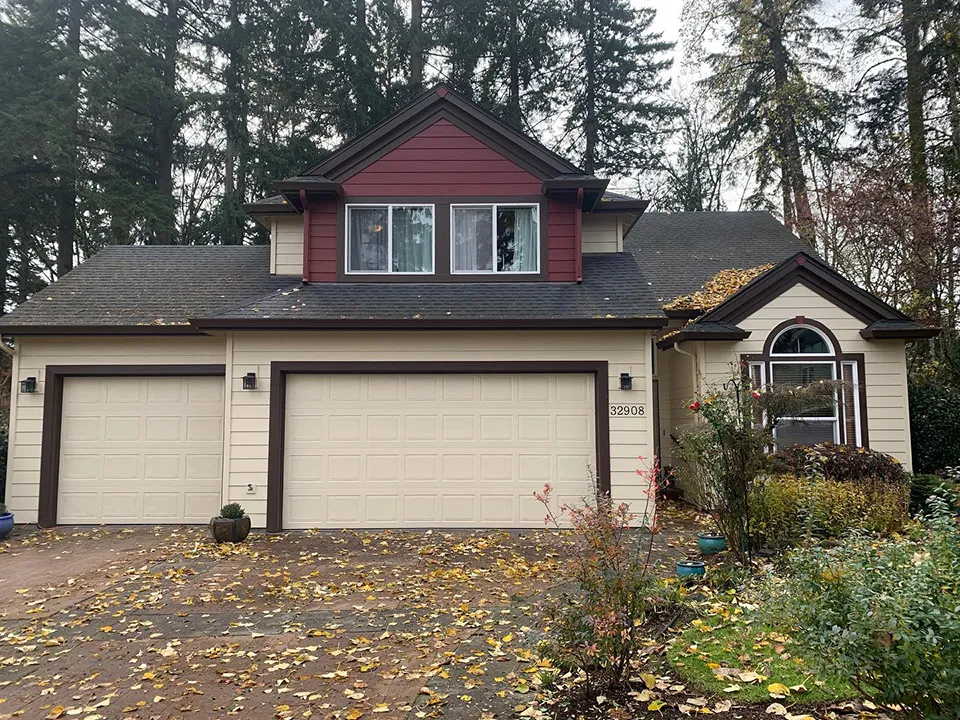
Professional Moss Removal Services
For extensive roof moss growth or if you are not comfortable working on your roof, hiring a professional is the safest and most effective option. Professional roof cleaning companies have the right equipment, safety gear, and expertise to remove moss without damaging your roof.
A+ Exterior Cleaning specializes in safe and effective roof cleaning. Our team uses a technique called soft washing. This method involves applying a specially formulated, eco-friendly cleaning solution at low pressure to kill the moss, algae, and lichen at the root. The solution is left to dwell, breaking down the organisms, which are then gently rinsed away. Soft washing is the preferred method for cleaning roofs because it is highly effective and poses no risk of damage to delicate materials like asphalt shingles.
Long-Term Moss Prevention
Once your roof is clean, you’ll want to keep it that way. Here are some preventative measures:
- Install Zinc or Copper Strips: Installing strips of zinc or copper along the ridge of the roof is a highly effective long-term solution. When it rains, water flows over the metal strips, picking up metallic ions that are toxic to moss and algae. This creates an environment where moss cannot grow.
- Trim Overhanging Branches: Prune any tree branches that hang over your roof. This will increase the amount of sunlight your roof receives, helping it to dry out faster and reducing the amount of debris that falls on it.
- Keep Gutters Clean: Regularly clean your gutters to ensure proper water drainage and prevent water from backing up onto the roof.
Protect Your Investment with Professional Cleaning
Your roof is one of the most critical components of your home, and protecting it from damage is essential. While a little green fuzz might seem harmless, moss can lead to serious and costly problems if ignored. By understanding why moss grows and taking proactive steps to remove and prevent it, you can extend the life of your roof and safeguard your home’s structural integrity.
If you’re dealing with a moss problem, don’t wait for the damage to get worse. A professional service for roof moss removal like A+ Exterior Cleaning can provide a safe, effective, and lasting solution. Our soft washing technique will restore the appearance of your roof and protect it for years to come. Contact us today for a free estimate and let our experts help you keep your roof in top condition.
https://www.google.com/maps?cid=9581861370272832557
